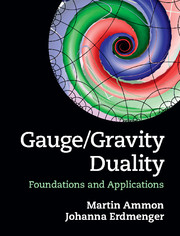Preface
Published online by Cambridge University Press: 05 May 2015
Summary
Gauge/gravity duality is a major new development within theoretical physics. It brings together string theory, quantum field theory and general relativity, and has applications to elementary particle, nuclear and condensed matter physics. Gauge/gravity duality is of fundamental importance since it provides new links between quantum theory and gravity which are based on string theory. It has led to both new insights about the structure of string theory and quantum gravity, and new methods and applications in many areas of physics. In a particular case, the duality maps strongly coupled quantum field theories, which are generically hard to describe, to more tractable classical gravity theories. In this way, it provides a wealth of applications to strongly coupled systems. Examples include theories similar to low-energy quantum chromodynamics (QCD), the theory of strong interactions in elementary particle physics, and models for quantum phase transitions relevant in condensed matter systems.
Gauge/gravity duality realises the holographic principle and is therefore referred to as holography. The holographic principle states that the entire information content of a quantum gravity theory in a given volume can be encoded in an effective theory at the boundary surface of this volume. The theory describing the boundary degrees of freedom thus encodes all information about the bulk degrees of freedom and their dynamics, and vice versa. The holographic principle is of very general nature and is expected to be realised in many examples. In many of these cases, however, the precise form of the boundary theory is unknown, so that it cannot be used to describe the bulk dynamics.
String theory, however, gives rise to a precise realisation of the holographic principle, in which both bulk and boundary theory are known: this is gauge/gravity duality. In this case, a quantum field theory at the boundary, which involves a gauge symmetry, is conjectured to be equivalent to a theory involving gravity in the bulk. Moreover, string theory provides many examples of dualities: a physical theory may generically have different equivalent formulations which are referred to as being dual to each other.
- Type
- Chapter
- Information
- Gauge/Gravity DualityFoundations and Applications, pp. ix - xiiPublisher: Cambridge University PressPrint publication year: 2015

